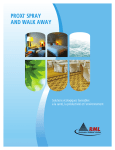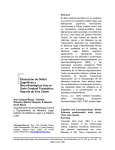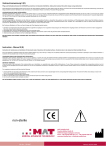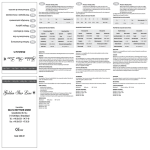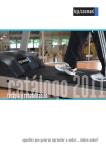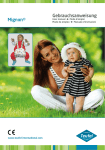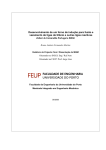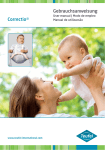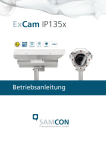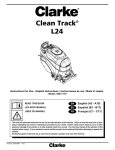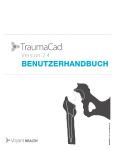Download Revision: 241005 non sterile - Erbrich
Transcript
2 non sterile GEBRAUCHSANWEISUNG 4. ( D ) 0483 Revision: 241005 Warnung: Die beschriebenen Implantate sind nur mit erbrich-Produkten kombinierbar ! IMPLANTAT – HÜFTENDOPROTHESE non-sterile ( KOPFPROTHESEN MIT BEZEICHNUNG MOORE UND THOMPSON ) IMPLANTAT WERKSTOFF : Implantate aus Stahl nach ISO 5832 – 1 :1997 Nichtrostender Stahl hergestellt von der Firma erbrich-Instrumente GmbH. Die Oberfläche dieser Implantate ist chemisch passiv , nicht magnetisch. Diese Implantate können mit dem genormten Werkstoff deren Zusammensetzung innerhalb der Norm festgelegten Richtanalyse nach der ISO 5832 – 1:1997 und den geforderten Spezifikationen kombiniert werden. Werkstofflegierungen mit Bestandteilen Chrom-Nickel ( Implantatstahl ) können in ihrer Eigenschaft eine sogenannte Chrom – Nickel - Allergie auslösen , sonst keine biokompatiblen Gefährdungen bekannt ! Wir weisen darauf hin , daß Implantate ihre Funktion nur dann korrekt erfüllen , wenn folgende Grundregeln beachtet werden: -Bei der Auswahl der Implantate ( Prothesen ), muß darauf geachtet werden , daß entsprechend dem Gewicht und dem Aktivitätsgrad des Patienten sowie dem zu versorgenden Hüftgelenk , das dementsprechenden Implantate ( Hüftprothese ) ausgewählt wird. Es ist darauf zu achten , daß durch geeignete Wahl der Biomechanik die von den Implantaten zu übertragenden Kräfte gering gehalten werden. Beschädigte oder Verformte Implantate dürfen nicht implantiert werden. -Eine Wiederverwendung von Implantaten ist absolut unteresagt ( Einmalverwendung ). -Wir raten dringend den Patienten über die Vor – und Nachteile von Implantaten zu informieren. -Übermäßige Belastung durch das Körpergewicht und den Aktivitätsgrad des Patienten sollte auf Grund der begrenzten Festigkeit der Implantate vermieden werden. Die Nichtbeachtung dieser Vorsichtsmaßnahmen kann schwerwiegende Folgen für den Heilungsprozess haben. PRÄOPERATIVE PLANUNG Die präoperative Planung gibt wichtige Informationen über die geeignete Prothese. Verschiedene Größen an Prothesen sollten zur Verfügung stehen , falls andere Größen benötigt werden oder die vorgesehene Prothese nicht verwendet werden kann. INDIKATIONEN Fortgeschrittene Abnutzung des Hüftgelenks auf Grund degenerativer , post -traumatischer oder rheumatischer Arthritis ; Fraktur oder avaskuläre Nekrose des Femurkopfes ; Folgezustand früherer Operationen , z.B. Osteosynthese , Gelenkrekonstruktion , Arthrodese. KONTRAINDIKATIONEN Akute – u. chronische Infektionen ; Muskel- , Nerven- oder Gefäßerkrankungen welche die betroffene Extremität gefährden ; fehlende Knochensubstanz oder mangelhafte Knochenqualität ( z.B. schwere Osteoporose ) ; Lokale Knochentumore. Systemerkrankungen und Stoffwechselstörungen ; Infektionen u. Stürze ; Drogenabhängigkeit ; Adipositas ; Große körperliche in Verbindung mit starken Erschütterungen verbundene Aktivitäten die zur Überbelastung des Implantats ( Prothese ) führen können. HINWEISE Alle dem Patienten gegebenen Informationen sollten vom Anwender dokumentiert und aufbewahrt werden. Vor der Anwendung sollte überprüft werden ob der Patient das zu implantierende Material verträgt. Implantate die in dieser Gebrauchsanweisung beschrieben sind , dürfen nur von Chirurgen mit angemessener Praxis , angewendet ( implantiert ) werden. MÖGLICHE NEGATIVE AUSWIRKUNGEN ( RISIKEN ) Lageveränderung und Lockerung der Prothese ; Luxation der Prothese ; Infektion ; Venöse Thrombose und Lungenembolie ; Kardiovaskuläre Störungen ; Hämatome REINIGUNG UND STERILISATION VON UNSTERILEN IMPLANTATEN Vor Gebrauch müssen die Implantate in einem validierten Verfahren sterilisiert ( autoklaviert ) werden. VALIDIERTE VERFAHREN DER ERBRICH – INSTRUMENTE GMBH STERILISATOR : Dampfautoklav , Temperatur = 121° bis 123° Celsius , Druck = 1 – 1,2 bar ( 15 bis 17 psi ) mit einer Einwirkzeit von mindestens 30 Minuten in eingepacktem Zustand. STERILISATOR : Autoklav mit Vorvakuum : Während der Vorvakuumphase wird zuerst die Luft aus der Kammer evakuiert , bevor der Dampf einströmt. Standardumlauf für verpackte Gegenstände : 132° bis 135° Celsius , Druck = 2 – 3 bar ( 27 bis 30 psi ) mit einer minimalen Einwirkzeit von 4 bis 10 Minuten. WICHTIGE HINWEISE : Vor jeder Verwendung bzw. Sterilisation sind die Implantate auf einwandfreie Funktion zu überprüfen! Bei Nichteinhaltung dieser Vorgaben bzw. nachweislichem Verstoss können keine Garantie oder Schadensersatzleistungen übernommen werden. INSTRUCTIONS FOR USE 4. (GB) Warning: The implants described may only be used in combination with erbrich products! IMPLANT – HIP ENDOPROSTHESIS non-sterile (HEAD PROSTHESES OF THE MOORE AND THOMPSON BRAND) IMPLANT MATERIAL: Implants made from steel in accordance with ISO 5832 – 1 :1997 Stainless steel manufactured by erbrich-Instrumente GmbH. The surface of these implants is chemically passive: not magnetic. These implants can be combined with the standardised material provided that its composition lies within the analysis stipulated in the ISO 5832 – 1:1997 standard and the required specifications. Material alloys with chrome-nickel (implant steel) components can trigger a so-called chrome-nickel allergy by their nature; there are no other known biocompatible hazards! We would point out that implants only function correctly if the following basic rules are observed: -When selecting implants (prostheses),care must be taken to choose the appropriate implant (hip prosthesis) on the basis of the weight and level of activity of the patient, and the hip joint to be treated. -Note that by making the correct choice of biomechanics the forces to be transferred by the implants remain low. Damaged or deformed implants must not be implanted. -The re-use of implants is absolutely forbidden (single use). -We strongly advise you to inform patients of the advantages and disadvantages ofimplants. -Excessive strain as a result of body weight and the level of activity of the patient should be avoided due to the limited strength of the implants. Failure to observe these precautionary measures can have serious consequences for the healing process. PREOPERATIVE PLANNING Preoperative planning provides important information on the suitable prosthesis. Different sizes of prosthesis should be available in case other sizes are required or the planned prosthesis cannot be used. INDICATIONS Advanced attrition of the hip joint owing to degenerative, post-traumatic or rheumatic arthritis; fracture or avascular necrosis of the femoral head; resulting condition of earlier operations e.g. osteosynthesis, joint reconstruction, arthrodesis. CONTRAINDICATIONS Acute and chronic infections; muscle, nerve or vascular diseases that endanger the affected extremity; a lack of bony tissue or poor bone quality (e.g. severe osteoporosis); local bone tumours. Systemic diseases and metabolic disorders; infections and falls; drug dependence; obesity; highly physical activities together with activities involving extreme vibrations which can lead to overstraining of the implant (prosthesis). NOTES The user should record and keep all information provided to the patient. It should be checked before use whether the patient tolerates the material to be implanted. The implants described in these instructions for usemay only be used (implanted) by surgeons with the appropriate experience. POSSIBLE NEGATIVE EFFECTS (RISKS) Displacement and loosening of the prosthesis; luxation of the prosthesis; infection; venous thrombosis and pulmonary embolism; cardiovascular disorders; haematomas CLEANING AND STERILISATION OF UNSTERILE IMPLANTS Before use, the implants must be sterilised using a validated procedure (autoclaved). ERBRICH – INSTRUMENTE GMBH VALIDATED PROCEDURES STERILISER:Steam autoclave: Temperature = 121° to 123° Celsius; Pressure = 1 – 1.2 bar (15 to 17 psi) with an exposure time of at least 30 minutes in the packaged state. STERILISER:Autoclave with prevacuum: During the prevacuum phase the air is extracted from the chamber before the steam flows in. Standard circulation for packaged objects: 132° to 135° Celsius; Pressure = 2 – 3 bar (27 to 30 psi) with an exposure time of at least 4 to 10 minutes. IMPORTANT NOTES: Every time the implants are used or sterilised you must first check that they function perfectly! In the event of failure to observe these instructions or demonstrable violation, no guarantee or compensation for damages can be provided. erbrich - instrumente GmbH Eugenstr. 33 · D-78532 Tuttlingen Tel.: +49 74 61 / 96 57 30 Fax: +49 74 61 / 9657 320 E-mail: [email protected] Website: www.erbrich-instruments.com MODE D’EMPLOI 4. (F) Avertissement : Les implants décrits ici ne peuvent être utilisés qu’avec des produits erbrich. IMPLANT – PROTHÈSE DE HANCHE non stérile (PROTHÈSES DE TÊTE SELON MOORE ET THOMPSON ) MATÉRIAU DE L’IMPLANT : Implants en acier selon l’ISO 5832 – 1 :1997 Fabriqués en acier inoxydable par la société erbrich-Instrumente GmbH. La surface de ces implants est chimiquement passive, non magnétique. Ces implants peuvent être utilisés avec le matériau standardisé dont la composition se situe à l’intérieur de l’analyse de référence de la norme pertinente selon l’ISO 5832 – 1:1997 et des spécifications imposées. Des alliages comprenant du nickel-chrome (acier d’implant) peuvent, de par leur nature, déclencher une allergie dite au nickel-chrome ; aucun risque biocompatible autre n’est connu. Nous attirons l’attention sur le fait que les implants ne peuvent remplir correctement leurs fonctions que si les principes de base suivants sont respectés : -Pour sélectionner des implants (prothèses), il faut veiller à ce que les implants (prothèses de hanche) correspondent au poids et au degré d’activité du patient, mais aussi à l’articulation coxo-fémorale à soigner. -La biomécanique choisie doit pouvoir réduire autant que possible les forces transmises par les implants. Ne pas mettre en place des implants endommagés ou déformés. -Il est absolument interdit de réutiliser des implants (usage unique). -Nous conseillons instamment d’informer le patient sur les avantages et les inconvénients des implants. -Les implants n’ont qu’une résistance limitée ; c’est pourquoi les patients ne devraient pas leur imposer des sollicitations excessives par une surcharge pondérale ou une activité physique non mesurée. Le nonrespect de ces mesures préventives peut entraîner des conséquences graves sur le processus de guérison. PLANIFICATION PRÉOPÉRATOIRE La planification préopératoire fournit des informations importantes sur la prothèse appropriée. Il est recommandé de disposer de différentes grandeurs de prothèses pour le cas où il faudrait d’autres dimensions ou au cas où il serait impossible d’utiliser la prothèse prévue. INDICATIONS Usure avancée de l’articulation coxo-fémorale suite à une arthrite dégénérative, post-traumatique ou rhumatismale, fracture ou nécrose avasculaire de la tête du fémur ; état consécutif à des opérations antérieures, par ex. ostéosynthèse, reconstruction articulaire, arthrodèse. CONTRE-INDICATIONS Infections aiguës et chroniques ; maladies musculaires, neurologiques ou vasculaires comportant des risques pour l’extrémité touchée ; substance osseuse déficiente ou mauvaise qualité de la substance osseuse (par ex. ostéoporose grave) ; tumeurs osseuses localisées ; maladies systémiques et troubles du métabolisme ; infections et chutes ; dépendance aux drogues ; adiposité ; exercice physique important lié à de fortes secousses, susceptibles de soumettre l’implant (la prothèse) à un effort excessif. REMARQUES L’utilisateur devrait noter toutes les informations remises au patient et conserver ses notes. S’assurer, avant emploi, que le patient n’est pas allergique au métal des implants. Les implants décrits dans le présent mode d’emploi ne doivent être utilisés (mis en place) que par des chirurgiens possédant l’expérience nécessaire. RÉPERCUSSIONS NÉGATIVES POSSIBLES (RISQUES) Déplacement et désolidarisation de la prothèse ; luxation de la prothèse ; infection ; thrombose veineuse et embolie pulmonaire ; troubles cardiovasculaires ; hématomes NETTOYAGE ET STÉRILISATION D’IMPLANTS NON STÉRILES Il est impératif de stériliser les implants avant emploi avec une méthode validée (par autoclave). MÉTHODES VALIDÉES PAR LA SOCIÉTÉ ERBRICH – INSTRUMENTE GMBH STÉRILISATEUR :En autoclave à la vapeur, température = de 121 °C à 123 °C, pression = de 1 à 1,2 bar (de 15 à 17 psi) pour une durée minimale de 30 minutes, après emballage. STÉRILISATEUR :Autoclave avec prévaporisation : L’air est évacué de la chambre pendant la phase de prévaporisation avant l’arrivée de la vapeur. Cycle standard pour objets emballés : de 132 °C à 135 °C, pression = de 2 à 3 bars (de 27 à 30 psi) pour une durée minimale de 4 à 10 minutes. REMARQUES IMPORTANTES : Vérifier le parfait fonctionnement des implants avant chaque emploi ou stérilisation. Aucune garantie et aucun dédommagement ne pourront être accordés en cas de non-respect de ces instructions, voire d’infraction prouvée à ces instructions. INSTRUCCIONES DE USO 4. (E) Advertencia: Los implantes aquí descritos solamente se pueden combinar con productos erbrich. IMPLANTE – ENDOPROTESIS DE CADERA no esterilizado (PROTESIS DE CABEZA CON DENOMINACION MOORE Y THOMPSON) MATERIALES DEL IMPLANTE: Implantes de acero conforme a ISO 5832 – 1 :1997 Acero inoxidable Fabricado por la empresa erbrich-Instrumente GmbH. La superficie de estos implantes es químicamente pasiva, no magnética. Estos implantes solamente pueden combinarse con el material estandarizado cuya composición se ajuste al análisis de referencia de la norma fijada conforme a ISO 5832 – 1:1997 y a las especificaciones pertinentes. Las aleaciones de materiales con contenido de cromo-níquel (acero de implante) pueden provocar por su propia naturaleza la denominada alergia al cromo-níquel; no se conocen otros riesgos de biocompatibilidad. Le advertimos de que los implantes solamente pueden cumplir correctamente su función si se respetan las siguientes reglas fundamentales: -Al seleccionar los implantes (prótesis) se debe tener en cuenta que los implantes -(prótesis de cadera) han de estar en concordancia tanto con el peso y el grado de actividad del paciente como con la articulación coxofemoral que se va a tratar. -Se debe tener en cuenta que la selección de la biomecánica adecuada permite limitar las fuerzas transmitidas por los implantes. No se deben emplear implantes deteriorados o deformados. -Se prohibe terminantemente volver a utilizar los implantes (uso único). -Se aconseja encarecidamente informar al paciente de las ventajas e inconvenientes de los implantes. -Debido a la limitada resistencia de los implantes se debe evitar someterlos a una carga excesiva como consecuencia del peso corporal y el nivel de actividad del paciente. La inobservancia de estas medidas de precaución podría comportar graves consecuencias para el proceso de rehabilitación. PLAN PREOPERATORIO El plan preoperatorio proporciona informaciones importantes acerca de la prótesis adecuada. Es necesario tener a disposición prótesis de diferentes tamaños para el caso de que resulte necesario aplicar otros tamaños o la prótesis prevista no pueda ser utilizada. INDICACIONES Desgaste avanzado de la articulación coxofemoral a causa de artritis degenerativa, posttraumática o reumática; fractura o necrosis avascular de la cabeza femoral; estado consecutivo de anteriores operaciones, p. ej. osteosíntesis, reconstrucción de articulación, artrodesis. CONTRAINDICACIONES Infecciones agudas y crónicas; afecciones musculares, nerviosas o vasculares que consti-tuyan algún riesgo para la extremidad afectada; pérdida de substancia ósea o calidad ósea deficiente (p. ej. osteoporosis grave); tumores óseos locales. Enfermedades sistémicas y trastornos metabólicos; infecciones y caídas; drogodependencia; adiposidad; intensa actividad corporal asociada a fuertes sacudidas que pudiera ocasionar una sobrecarga de los implantes (prótesis). OBSERVACIONES El usuario debe documentar y conservar todas las informaciones que haya proporcionado al paciente. Antes de la aplicación hay que verificar si el paciente está en condiciones de tolerar el material que se va a implantar. Los implantes que se describen en estas Instruccio-nes de uso solamente deben ser aplicados (implantados) por cirujanos con la experiencia adecuada. POSIBLES EFECTOS SECUNDARIOS (RIESGOS) Dislocación y aflojamiento de la prótesis; luxación de la prótesis; infección; trombosis venosa y embolia pulmonar; trastornos cardiovasculares; hematomas LIMPIEZA Y ESTERILIZACION DE IMPLANTES NO ESTERILIZADOS Los implantes, antes de su aplicación, han de someterse a un procedimiento de esterilización validado (autoclave). PROCEDIMIENTOS VALIDADOS POR ERBRICH – INSTRUMENTE GMBH ESTERILIZADOR:Autoclave por vapor, temperatura = 121° hasta 123° Celsio, presión = 1-1,2 bares (15 hasta 17 psi) con un tiempo de incidencia de 30 minutos en condiciones de envasado. ESTERILIZADOR: Autoclave por vacío previo: En la fase de vacío previo hay que evacuar el aire de la cámara antes de que el vapor afluya. Circulación estándar en objetos envasados: 132° hasta 135° Celsio, presión = 2 – 3 bares (27 hasta 30 psi) con un tiempo de incidencia mínimo entre 4 y 10 minutos. AVISOS IMPORTANTES: Antes de cada uso y/o esterilización hay que comprobar que los implantes funcionen debidamente. En caso de inobservancia de estas indicaciones o contravención demostrables de las mismas el fabricante no asumirá garantía ni restituirá indemnización alguna. ISTRUZIONI PER L’USO 4. (I) Avvertenza: Gli impianti descritti possono essere combinati esclusivamente con i prodotti erbrich IMPIANTO PER ENDOPROTESI D’ANCA non sterile (PROTESI DI TESTE FEMORALI CON DENOMINAZIONE MOORE E THOMPSON) MATERIALE DEGLI IMPIANTI: Impianti in acciaio ai sensi di ISO 5832 – 1:1997 Acciaio inossidabile prodotto dalla ditta erbrich-Instrumente GmbH. La superficie degli impianti è chimicamente passiva, non magnetica. Questi impianti possono essere combinati con il materiale standard la cui composizione rientra nella norma dell’analisi di riferimento stabilita ai sensi di ISO 5832 -1:1997 e delle specifiche necessarie. Per la loro stessa natura, le leghe di materiali contenenti nichelcromo (acciaio per impianti) possono causare una cosiddetta allergia al nichelcromo; non sono noti altri rischi di biocompatibilità! Si ricorda che gli impianti svolgono correttamente la loro funzione solo se vengono rispettate le seguenti regole fondamentali: -Al momento della scelta degli impianti (protesi), è necessario selezionare gli impianti (protesi d’anca) adatti, in modo tale da tenere conto non solo del peso e del grado di attività del paziente, ma anche dell’anca da trattare. -Tenere in considerazione che una scelta oculata in termini di biomeccanica consente di limitare le forze che verranno trasmesse dagli impianti. Non utilizzare impianti danneggiati o deformati. -Gli impianti non possono assolutamente essere riutilizzati (un solo impiego). -Si consiglia vivamente di informare i pazienti dei vantaggi e degli svantaggi degli impianti. -A causa della limitata resistenza degli impianti, è necessario evitare un sovraccarico dovuto al peso corporeo e al grado di attività del paziente. La mancata osservanza di queste misure precauzionali può avere gravi conseguenze sul processo di guarigione. PIANIFICAZIONE PREOPERATORIA La pianificazione preoperatoria fornisce importanti informazioni sulla protesi adatta. È necessario tenere a disposizione protesi di diverse taglie, nel caso in cui risultasse necessario ricorrere a taglie diverse o la protesi prevista non potesse essere utilizzata. INDICAZIONI Usura avanzata dell’anca dovuta ad artrite degenerativa, post-traumatica o reumatica; frattura o necrosi avascolare della testa del femore; condizione secondaria a precedenti interventi, ad es. osteosintesi, ricostruzione dell’articolazione, artrodesi. CONTROINDICAZIONI Infezioni acute e croniche; affezioni muscolari, nervose e vascolari che mettono a rischio le estremità interessate; mancanza di sostanza ossea o scarsa qualità dell’osso (ad es. osteoporosi grave); tumori ossei localizzati. Malattie sistemiche e disturbi metabolici; infezioni e cadute; tossicodipendenza; adiposità; intense attività fisiche associate a forti vibrazioni che possono determinare un sovraccarico dell’impianto (protesi). NOTE Tutte le informazioni fornite al paziente devono essere documentate e conservate dall’utilizzatore. Prima dell’impiego, è necessario verificare se il paziente è in grado di tollerare il materiale da impiantare. Gli impianti descritti nelle presenti istruzioni per l’uso devono essere utilizzati (impiantati) esclusivamente da chirurghi in possesso della necessaria esperienza. POSSIBILI EFFETTI NEGATIVI (RISCHI) Migrazione e allentamento della protesi; lussazione della protesi; infezione; trombosi venosa ed embolia polmonare; disturbi cardiovascolari; ematomi. PULIZIA E STERILIZZAZIONE DI IMPIANTI NON STERILI Prima dell’utilizzo, gli impianti devono essere sterilizzati (autoclavati) in base ad una procedura validata. PROCEDURE VALIDATE DELLA ERBRICH– INSTRUMENTE GMBH STERILIZZATORE: Autoclave a vapore d’acqua, temperatura = 121° - 123° Celsius, pressione = 1-1,2 bar (15 - 17 psi) con tempo di azione di almeno 30 minuti sul prodotto confezionato. STERILIZZATORE: Autoclave a prevuoto: durante la fase di prevuoto, l’aria viene innanzitutto estratta dalla camera, prima di procedere all’introduzione del vapore. Ciclo standard per oggetti confezionati: 132° - 135° Celsius, pressione = 2 – 3 bar (27 - 30 psi) con tempo di azione minimo di 4 - 10 minuti. INDICAZIONI IMPORTANTI: Prima di ciascun impiego o sterilizzazione, verificare che gli impianti siano perfettamente funzionali! La ditta produttrice non concederà alcuna garanzia o risarcimento dei danni in caso di mancata osservanza di queste prescrizioni o qualora venga dimostrata una violazione.


